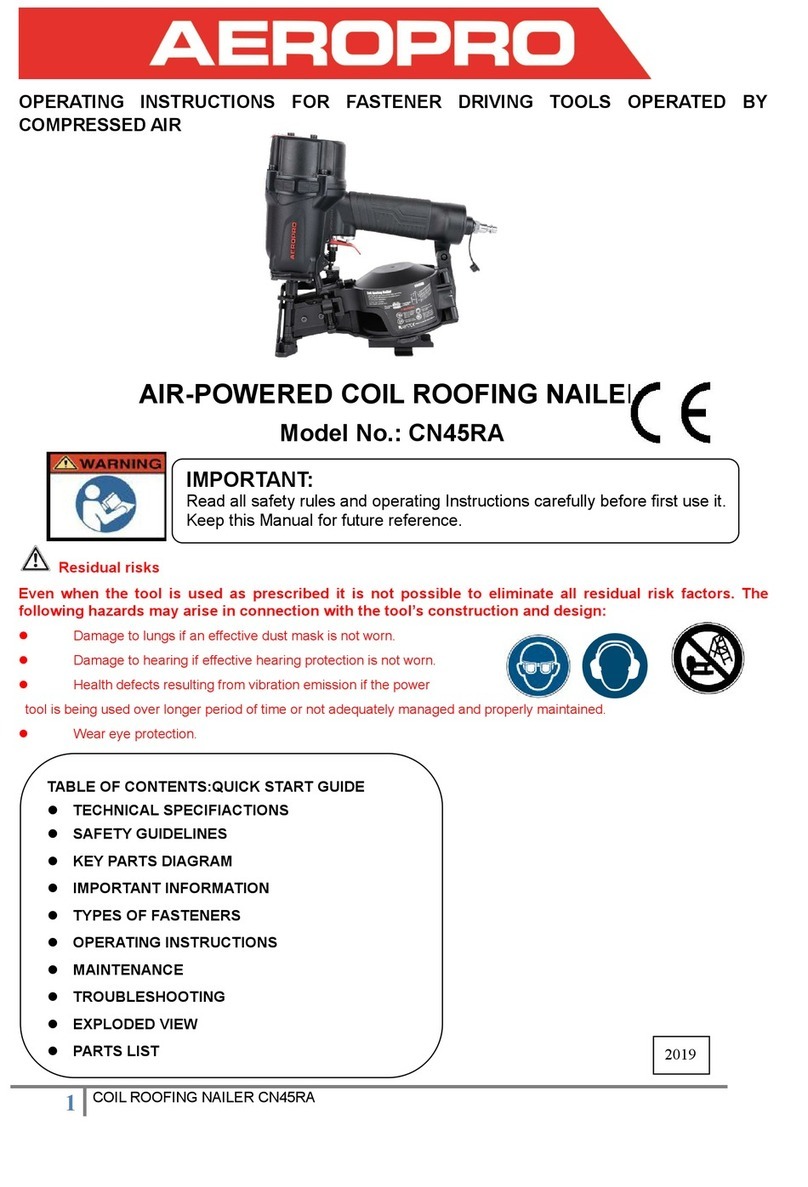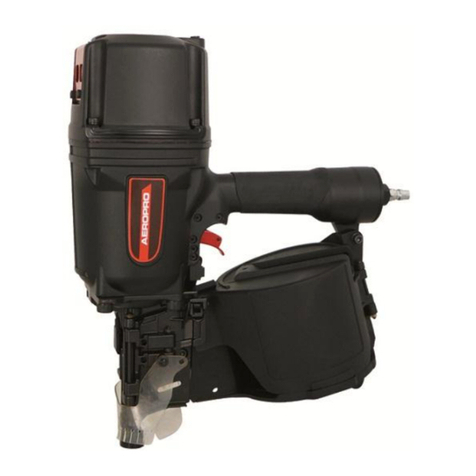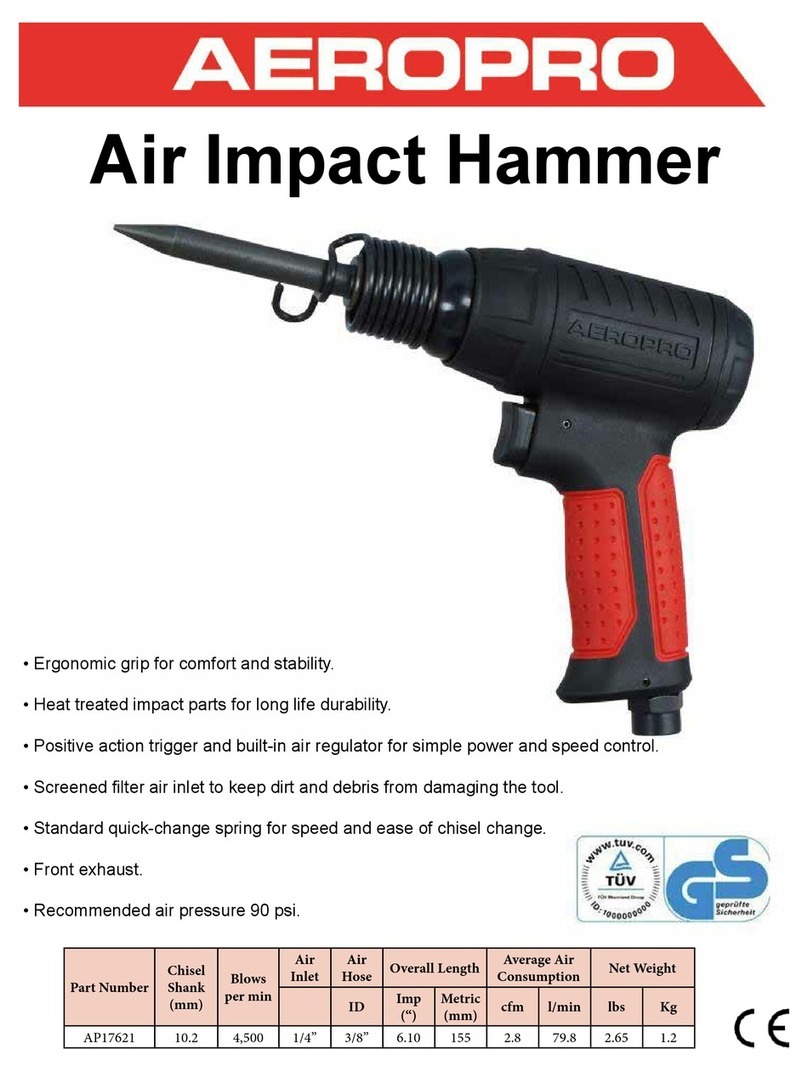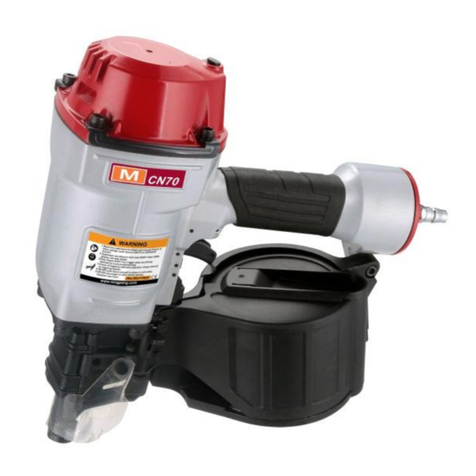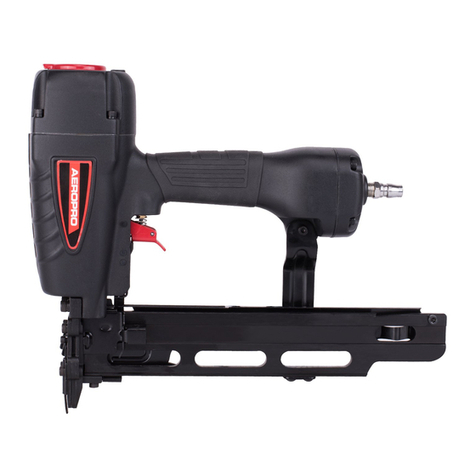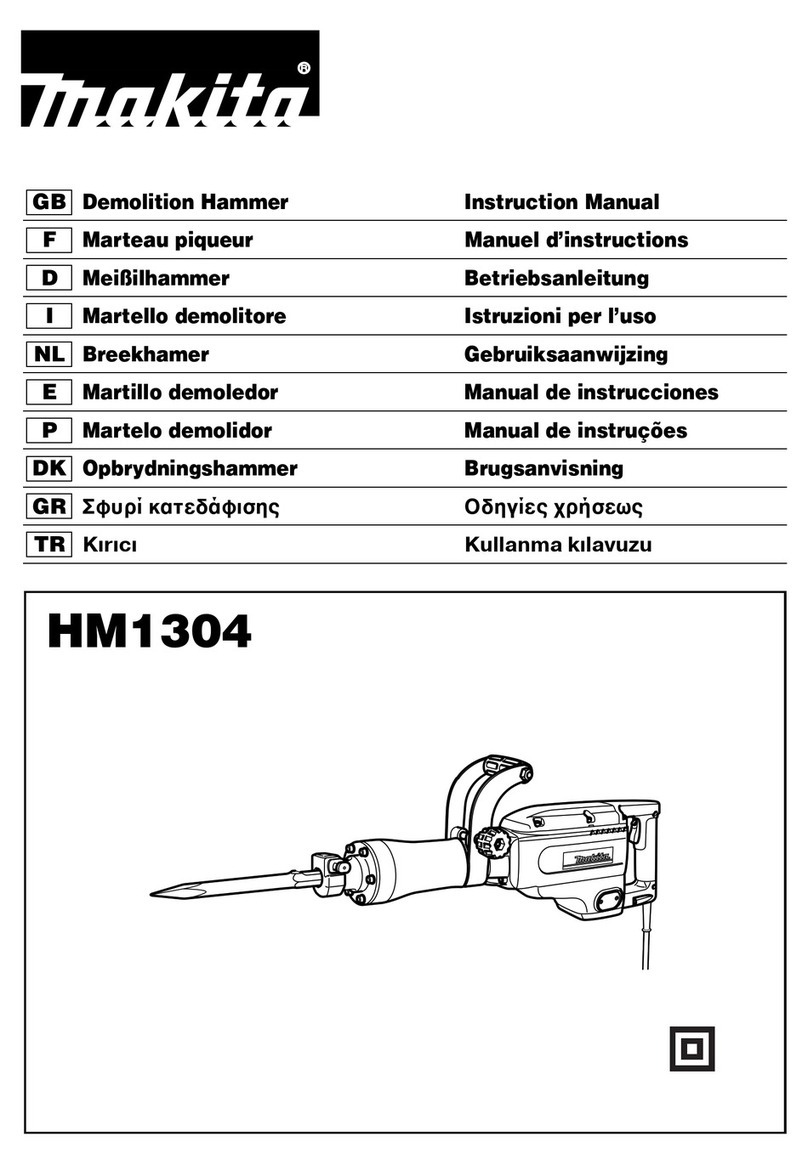Aeropro CN65ZRA User manual

1
INSTRUCTION MANUAL
AIR-POWERED COIL NAILER
CN65ZRA
IMPORTANT:
Read all safety rules and operating Instructions
carefully before starting the product.
Keep this Manual for future reference.
Residual Risks
Even when the tool is used as prescribed it is not possible to eliminate all residual risk factors.
The following hazards may arise in connection with the tool’s construction and design:

2
TABLE OF CONTENTS:
TECHNICAL SPECIFIACTIONS
SAFETY GUIDELINES
KEY PARTS DIAGRAM
IMPORTANT INFORMATION
TYPES OF FASTENERS
OPERATING INSTRUCTIONS
MAINTENANCE
TROUBLESHOOTING
EXPLODED VIEW
PARTS LIST
TECHNICAL SPECIFIACTIONS:
Magazine
capacity(QTY.)
300 nails (1 coil)
Fastener Details
0º1-1/2” to 2-1/2” Plastic Coil Nails
Operating
pressure:
70 –120 psi (4.9 –8.3bar 5 –8.5 kgf/cm2)
Maximum pressure:
120PSI (8.3bar)
Air consumption:
.049 ft3/cycle at 90 psi
Air inlet:
3/8”
Dimensions:
282mm*316mm*145mm(11.1"*12.44"*5.71")
Weight:
2.3kgs(5.06lbs)
SCFM: Standard Cubic feet per minute (the volumetric flow rate of air corrected to standardized conditions of
temperature and pressure).
Environmental Responsibilities
Please recycle unwanted materials instead of disposing of them as waste. All tools, hoses and packaging should be
sorted, taken to the local recycling centre and disposed of in an environmentally safe way.

3
SAFETY GUIDELINES
This manual contains information that relates to protecting personal safety and preventing equipment problems.it is
very important to read this manual carefully and understand it thoroughly before using the product.the symbols listed
below are used to indicate this information.
DANGER!
Potential hazard that will result in serious injury or loss of life.
WARRNING!
Potential hazard that could result in serious injury or loss of life.
CAUTION!
Potential hazard that may result in moderate injury or damage to equipment.
Note-The word“note”is used to inform the reader of something he/she needs to know about the tool.
PERSONAL SAFETY
These precautions are intended for the personal safety of the user and others working with the user. please take time
to read and understand them.
DANGER!
Potential hazard that will result in serious injury or loss of life.
-Keep children away from the work area. Do not allow children to handle power tools.
-Keep air hose away from heat, oil, and sharp edges. Check air hose for wear before each use and ensure that all
connections are proper. Always ensure that the workpiece is firmly secured leaving both hands free to control the
tool.Always ensure that the tool has stopped before putting it down after use, in the interest of safety and to prevent
possible damage to the tool/user.
-Keep proper footing at all times in order to ensure correct balance.
Do not use oxygen or any other combustible or bottled gas to power air-powered
tools. Failure to observe this warning can cause explosion and serious personal
injury or death. Use only the compressed air to power the air-powered tools. Use a
minimum of 25’(7.6m) of hose to connect the tools to the compressor. Failure to
comply will result in serious injury or loss of life.
Risk of electric shock: Do not expose a compressor to rain. Store it indoors. Disconnect the
compressor from power source before servicing. Compressor must be grounded. Do not use grounding
adaptors.
Risk of personal injury: Do not direct compressed air from the air hose toward the user or other
personnel.
Risk of inhalation: Never directly inhale the air produced by the compressor.
Risk of bursting: Do not adjust the pressure switch or safety valve for any reason. They have been
preset at the factory for this compressor’s maximum pressure. Tampering with the pressure switch or the
safety valve may cause personal injury or property damage.
Risk of burns: The pump and the manifold generate high temperatures. In order to avoid burns or other
injuries, do not touch the pump, the manifold or the transfer tube while the compressor is running. Allow
the parts to cool down before handling or servicing. Keep children away from the compressor at all times.
Risk of bursting: Make sure the regulator is adjusted so that the compressor outlet
pressure is set lower than the maximum operating pressure of the tool. Before
starting the compressor, pull the ring on the safety valve to make sure the valve
moves freely. Drain water from tank after each use. Do not weld or repair tank.
Relieve all pressure in the hose before removing or attaching accessories.
WARNING!
Potential hazard that could result in serious injury or loss of life.
-Do not allow unskilled or untrained individuals to operate the air powered tools.
-Do not use the air powered tools for any task other than that it is designed to perform.

4
-Do not use the air tools unless you have been trained to do so. Only a qualified person should use the tool.
-Locate the compressor in a well-ventilated area for cooling, and must be a minimum of 12”(31cm) away from the
nearest wall.
-Protect the air hose and the power cord from damage and puncture. Inspect them for weak or worn spots every
week, and replace them if necessary .
-Always wear hearing protection when using the air compressor. Failure to do so may result in hearing loss.
-Do not carry the compressor while it is running.
-Do not operate the compressor if it is not in a stable position.
-Do not operate the compressor on a rooftop or in an elevated position that could allow the unit to fall or be tipped
over.
Always replace a damaged gauge before operating the unit again.
CAUTION!
Potential hazard that may result in moderate injury or damage to equipment.
-Always ensure that the tool has stopped before connecting to the air supply.
-Do not wear watches, rings, bracelets, or loose clothing when using any air tool.
-Do not overload the tool.Allow the tool to operate at its optimum speed for maximum efficiency.
-Do not use a tool that is leaking air, with missing or damaged parts, or that requires repairs. Verify that all screws are
securely tightened.
-For optimal safety and tool performance, inspect the tool daily in order to ensure free movement of the trigger, safety
mechanisms, and springs.
-Always keep your air tools clean and lubricated. Daily lubrication is essential to avoid internal corrosion and possible
failures.
-Ensure the floor is not slippery and wear non-slip shoes. Floors should be kept clean can clear.
-Always follow all workshop safety rules, regulations, and conditions when using the tools.
-Carry the tool by the handle only. Do not carry the tools with a finger on the trigger. Do not carry the tool by the hose,
magazine or any other parts.
-Do not use the tool near or below freezing temperatures, as doing so may cause tool failure.
-Do not store the tool in a freezing environment to prevent ice formation on the operating valves of the tool, as doing
so may cause tool failure.
-Handling and storage of oil: Use with adequate ventilation. Avoid contact of oil with eyes, skin, and clothing. Avoid
breathing spray or mist. Store in a tightly closed container in a cool, dry, well-ventilated area free
from incompatible substances.
CAUTION!
Potential hazard that may result in moderate injury or damage to equipment.
Disconnect tool from the air supply and turn off the compressor before performing any maintenance,
or changing accessories, when the tool is not in use, when it is being handed to another person,
and when it is left unattended. Failure to comply may result in moderate injury or damage to equipment.
Use safety goggles and ear protection:
-Wear safety glasses with side shields when operating the tool/compressor and verify that others in
the work area are also wearing safety glasses.
-Requirements and must provide protection from flying particles from the front and the sides.
-Air powered tools are loud and the sound can cause hearing damage. Always wear ear protection
to prevent hearing damage and loss. Failure to comply may result in moderate injury.
NOTE: Recycle unwanted materials father than disposing of them as waste. Sort the tools, hoses, and package into
specific categories and take to the local recycling centre or dispose of them in an environmentally safe way.

5
KEY PARTS DIAGRAM
IMPORTANT INFORMATION
Compatible compressors
GUIDELINES FOR PROPER USE AND OPERATION
Be sure to use a proper air compressor with air powered tools.
General use
The Air-Powered Coil Siding Nailer. drives 1-1/2” to 2-1/2” 0ºplactic coil nails. The tool is lightweight and durable,
stands up to the elements and provides consistently accurate results over the life of the tool. An ideal tool for a
variety of construction projects, including installation of asphalt roofing shingles and insulation boards. It also
features a high-capacity side-load magazine, tool-less depth adjustment, durable construction, and more.
Air system
Always use clean, dry, regulated, compressed air at 4.9 to 8.3 bar (70 to 120psi).
Do not exceed the maximum or minimum pressures. Operating the tool at the wrong pressure(too low or too
high) will cause excessive noise or rapid wear of tool.
Table of contents
Other Aeropro Power Tools manuals

